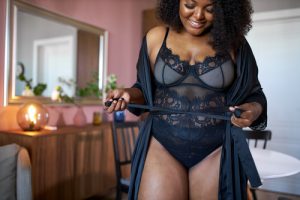Despite the 32 billion views on TikTok for ‘plus-size’ and the plus-size clothing market estimated to be worth over £9 billion in 2022, less than 1% of models at the AW/23 fashion week were plus-size.
With this in mind, fashion experts at JOOR have collated the biggest plus-size consumer complaints and tips for brands to better cater to plus-size shoppers.
1. Having a small size range
 According to @creativehouseuk, the first step for brands to embrace size inclusivity is expanding size ranges to 5XL or over.Additionally, consumers want brands to sell larger sizes at the same price.
According to @creativehouseuk, the first step for brands to embrace size inclusivity is expanding size ranges to 5XL or over.Additionally, consumers want brands to sell larger sizes at the same price.
Fashion experts at JOOR say:
“Fashion is for everyone, and the plus-size clothing market is a fast-growing segment in the industry; brands need to see a bigger picture in terms of inclusivity as well as profit.”
2. Only adding width and length
Increasing the sizing range is a significant first step for brands, but that doesn’t just mean adding width and length. @wtfoffashion suggests one problem with plus-size clothing is brands not catering to plus-size bodies. Avoiding the standard straight cut and focusing on how different proportions look as the size increases could help brands be more plus-size inclusive.
“Every person has a different style and body shape, so styling for just one eliminates consumers’ ability to feel confident in what they wear.” Says JOOR.
3. One size fits all accessories
 A range of sizes built for different bodies should also apply to accessories; for example, @wtfoffashion also explores the importance of inclusivity across jewellery by expanding size ranges to rings, belts and shoes as well as clothing items, alongside talking about how @soulrainebodyworks does a beautiful job at including all sizes in their accessory range.
A range of sizes built for different bodies should also apply to accessories; for example, @wtfoffashion also explores the importance of inclusivity across jewellery by expanding size ranges to rings, belts and shoes as well as clothing items, alongside talking about how @soulrainebodyworks does a beautiful job at including all sizes in their accessory range.
4. Style and plus-sized are not mutually exclusive
TikTok users like @b1gbimbo and @officialcatieli have complained about the lack of style in plus-size clothing, such as focusing on floral prints and lack of trending styles. To avoid this, brands should aim for cohesive styles with other ranges instead of creating a limited plus-size selection and showing trending patterns are attainable to all sizes.
“The opportunity for trending fashion is endless, and injecting the same passion from standard size lines into plus-sizes can show the consumer everyone has been thought about,” JOOR advises.
5. Lack of digital offering
As showcased by @_katiefrances, not knowing how a garment will look can be stressful, especially for plus-sized people. In a digital world, investing in and adopting new technologies is a great way for brands to improve the shopping experience – Strategies like online virtual changing rooms can alleviate common stresses for plus-size consumers.
JOOR comments:
“Experimenting with digital shopping experiences is a great way to showcase pieces whilst alleviating a primary stress for plus-size consumers.”
6. Not showing plus-size models
According to TikTok user @hannahleelifestyle, the best way to market plus-size ranges is to let consumers view the product based on the body type it was made for. 1.6 million people liked this example that included representation in marketing from @jessakae, where women of all shapes, heights and races model the clothing for each size.
7. Separating plus-size collections
Plunkettresearch.com estimated that 68% of American women are over a size 14 (UK 16), meaning that most consumers are considered plus-size. Glamour.com have suggested that the term ‘plus-size’ might be an outdated way to describe the vast majority of consumers. The best way brands can avoid this is to integrate sizes with main collections.
8. Being inauthentic
Being upfront about stock sizes is a must for brands. Listening to what customers have to say and diving deeper into the target audience is a great way to figure out ways to alleviate concerns and ensure every body type has a voice.





